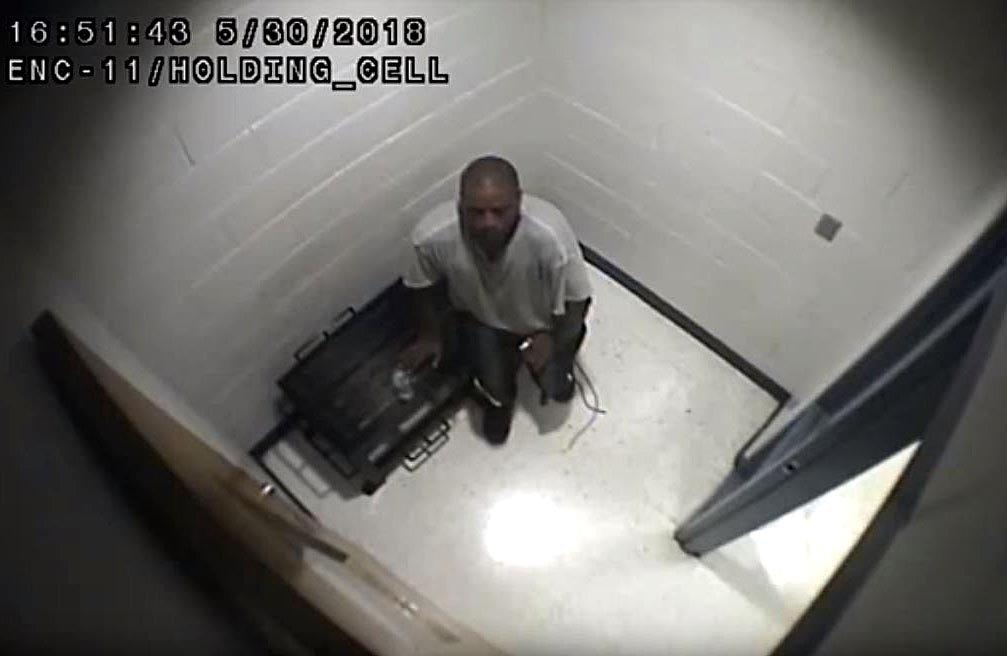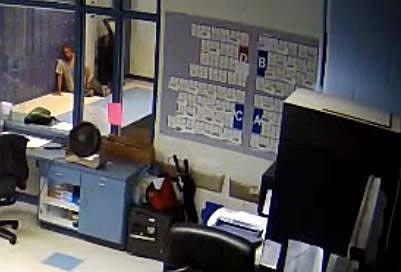Inmate Felix Manus died June 11. His family’s lawyer says county officers delayed calling 911 when Manus suffered an asthma attack in May.
Newly released surveillance video footage from inside the Erie County work-release center offers the clearest view yet into the treatment of inmate Felix L. Manus, who died June 11.
But the significance of the footage, which the Erie Times-News received after filing a Right-to-Know request, is in dispute.
Erie County Solicitor Richard Perhacs has said that the video footage appears to contradict some claims the Manus family’s lawyer, John Mizner, has raised, such as his description of Manus’ level of distress while at the work-release center.
Mizner said Wednesday that the footage confirms that county corrections officers failed to provide Manus with adequate medical care after he suffered an asthma attack during a work-release shift near Edinboro on May 30.
The footage shows Manus entering the work-release facility with a stiff gait and waiting for emergency medical care in a holding cell. Manus is able to walk and talk in the video clips, but at one point lowers himself to the floor.
The videos do not clarify what has become a key question in the case: when Erie County corrections officers called for emergency medical assistance for Manus. Emergency personnel arrived at the work-release center about 20 minutes after Manus entered the building, the videos show.
Perhacs said Wednesday that he did not know when 911 was called during the incident.
“Obviously an ambulance arrives during the filming, so somebody called them, but I don’t know the details of the timing on that,” he said.
Manus, 48, died June 11 at UPMC Hamot. His family has said that he never regained consciousness after suffering cardiac arrest because of a lack of oxygen.
Mizner charges that a corrections officer delayed calling 911 and instead transported Manus back to the county work-release center, at 450 E. 16th St., when Manus suffered an asthma attack after the work-release detail near Edinboro that included tasks such as cutting grass.
The time-stamped videos from Erie County show Manus, in a white shirt, leaving the work-release facility at 9:08 a.m. and returning at 4:46 p.m. The videos do not include audio.
Manus walks normally and interacts with another inmate in the morning videos. At one point in the morning, Manus appears to stop and smoke a cigarette.
When Manus returned to the facility in the late afternoon, the videos show, his walk had become stilted and his shoulders hunched. Inside the work-release center, as shown in the upper right corner of the video, he stands with his hands on his knees and then slowly lowers himself to the floor.
About three minutes later, a female corrections officer and another inmate help Manus stand up. With assistance from the corrections officer, Manus walks to a holding cell in the work-release center and sits down.
Manus seems to be struggling to breathe in the videos, but he also appears to talk several times while seated in the holding cell. Two male corrections officers bring him water. One of the officers fans him with a clipboard.
At about 5:06 p.m., Manus stands up and loads himself onto a stretcher brought into the center by emergency personnel.
Perhacs, who released the videos to the Times-News, declined to identify the three corrections officers shown in the video, or to say whether any of them are the two officers whom the county disciplined in connection with the Manus case.
For that reason, the Times-News has obscured the faces of the corrections officers when they are easily recognizable in the videos at www.GoErie.com/videos. The faces of inmates have also been obscured. The Times-News also labeled the videos and edited them for length.
Perhacs said Wednesday that the footage speaks for itself.
“I think it shows that Mr. Manus was ambulatory, was able to walk, was able to talk, and was able to get himself onto the stretcher,” Perhacs said. “Any statements inconsistent with what the video shows are obviously wrong.”
Perhacs has said the footage appears to be inconsistent with claims made by Mizner, the lawyer for the Manus family.
In a June 4 letter to Erie County Executive Kathy Dahlkemper, Mizner charged that Manus’ condition had deteriorated so dramatically during the asthma attack that four other work-release inmates had to carry him into the center when they arrived.
The video shows Manus walking into the work-release center on his own.
Mizner said Wednesday he remains confident in the information presented in the letter.
“If I were to rewrite this I would change the word ‘carried’ to ‘assisted,’” Mizner said. “I used the information that was provided to me by witnesses, but in retrospect, ‘assisted’ would have been more accurate having seen the video.
“However, that does not change anything else in this letter. The fact remains that 911 should have been called from Edinboro.”
Mizner had not seen the footage before the Times-News approached him Wednesday morning. He has since received the videos, he said late Wednesday.
Mizner said the videos show Manus was in need of medical care.
“Everything that I see in the video confirms a man with a serious medical need being denied medical attention, and that’s a violation of Mr. Manus’ constitutional rights,” Mizner said.
He said Manus’ family is awaiting the results of a June 13 autopsy before deciding whether to file a lawsuit. Those results are pending the completion of microscopic studies, Erie County Coroner Lyell Cook has said.
Court records show that Manus was ordered on May 4 to serve three months of work release unless he paid child support he owed.
Dahlkemper’s administration has also referred the case to the Erie County District Attorney’s Office, which is conducting an independent investigation.
Dahlkemper said at a June 14 news conference that the county’s internal investigation into the matter found no malice on the part of the corrections officers. The county has declined to describe the nature of the discipline that two officers received, citing its contract with the corrections officers’ union. The officers were not fired or demoted, a previous Times-News Right-to-Know request showed.
Perhacs said at the news conference that the two officers were disciplined because the county did not believe they used appropriate judgment.
Perhacs on Wednesday declined to comment on investigative materials in the case, including whether the officers shown in the surveillance video footage acted appropriately.
Erie County has made changes to its inmate transport policy in the wake of the incident. The policy previously did not direct corrections officers to call 911 if a medical emergency occurred during transport. The updated policy tells officers to call 911 first an await medical assistance if an inmate becomes ill.
Original article by: Madeleine O’Neill can be reached at 870-1728 or by email. Follow her on Twitter at twitter.com/ETNoneill.






![Erie County Executive Kathy Dahlkemper and Erie County Solicitor Richard Perhacs spoke at a June 14 news conference on the Felix Manus case. [MADELEINE O’NEILL/ERIE TIMES-NEWS]](https://images.squarespace-cdn.com/content/v1/58a0771ecd0f68e8d03f480d/1530635537990-IWG39EWZC7W10ONT5RE0/EP-180628519+%282%29.jpg)